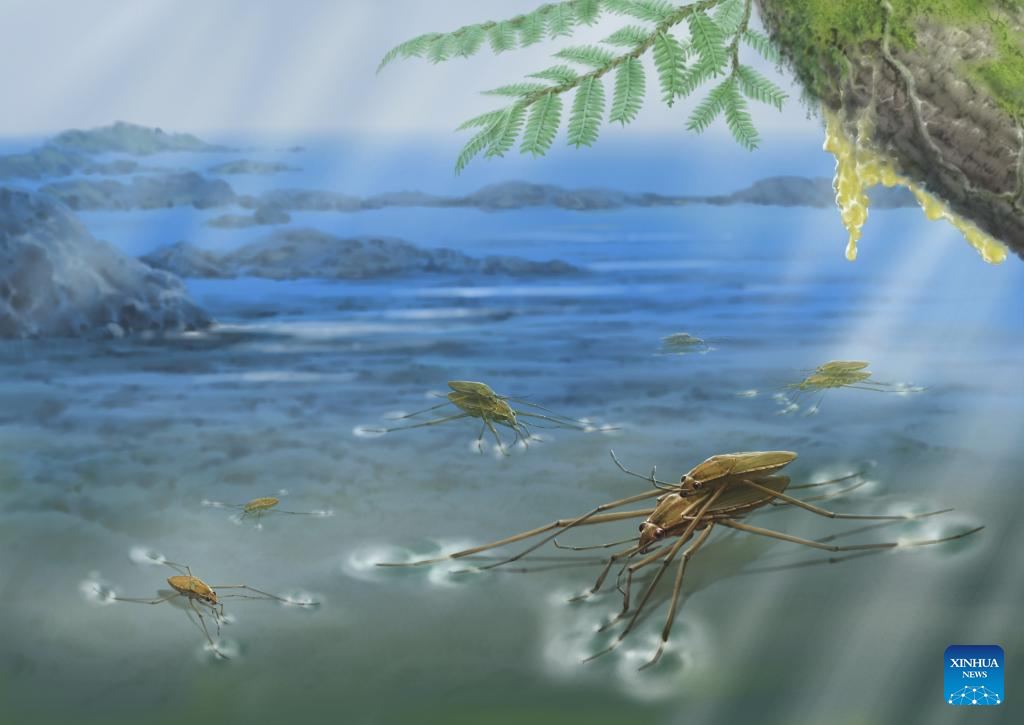

This image provided by the Nanjing Institute of Geology and Palaeontology, Chinese Academy of Sciences (NIGPAS) shows a reconstructed ecological environment millions of years ago when two water striders were engaged in copulation. (NIGPAS/Handout via Xinhua)
The discovery of a group of water striders trapped in amber, engaged in copulation millions of years ago, has sparked excitement among scientists, providing a unique opportunity for researchers to gain insights into the behaviors of ancient insects.
Chinese researchers have revealed the mating behavior and potential sexual conflicts of the insects through the first fossil record of Cretaceous water striders in copulation from northern Myanmar, which dated back to the mid-Cretaceous some 100 million years ago.
The findings were published in Proceedings of the Royal Society B on April 3.
Fossilized mating insects are an irreplaceable tool for understanding the evolution of mating behaviors and life history traits in the deep-time record of insects, according to the research team led by Huang Diying, a professor at the Nanjing Institute of Geology and Palaeontology of the Chinese Academy of Sciences.
The specimen reported in this study contains seven adult water striders (also known as Burmogerris rarus), including three paired individuals and a single adult male, and four recognizable water strider nymphs enclosed in the amber piece. Of these, two pairs were captured in mating situations, with smaller males riding on the backs of the females.
Catching insects during copulation, especially aquatic species, is a rarity in the fossil record. The findings are of great help in deepening understanding of relevant behavioral strategies across geological time periods among scientists, Huang said.
In addition, two pairs and a single male appear to have been preserved in the same layer near the upper surface of the amber. "We speculate that the small-sized male Burmogerris rarus is unlikely to be territorial, while this species maintains a high population density in the Myanmar amber forest," said Fu Yanzhe, a member of the research team.
Microscopic analysis also identified differences between the front legs of the males and females that may have played a role during and after mating. In males, a section called the protibia is slightly curved while it is straight in females. In addition, it features a comb-like structure on its edge, which females do not have.
"By comparing the male's protibial combs with species in the related family Veliidae, we suggest that the specialized protibial comb of the new fossils functions as a grasping apparatus, likely representing an adaptation to overcome female resistance during struggles," Huang said.
These paired fossils probably represent a stage of precopulatory struggle or postcopulatory contact guarding. Males used such contact guarding to prolong mating, thereby avoiding sperm competition, according to the researchers.
The specialized morphology and diverse behavior of gerromorphans, including water striders and their relatives, have become hot research topics in evolutionary biology, ecology and even interdisciplinary studies, and have provided a theoretical basis for the development of biomimetic technology on water surface, the researchers noted. (Xinhua)

This combo photomicrograph provided by the Nanjing Institute of Geology and Palaeontology, Chinese Academy of Sciences (NIGPAS) shows details of water striders enclosed in amber. (NIGPAS/Handout via Xinhua)

This combo photomicrograph provided by the Nanjing Institute of Geology and Palaeontology, Chinese Academy of Sciences (NIGPAS) shows details of water striders enclosed in amber. (NIGPAS/Handout via Xinhua)

86-10-68597521 (day)
86-10-68597289 (night)

52 Sanlihe Rd., Xicheng District,
Beijing, China (100864)

